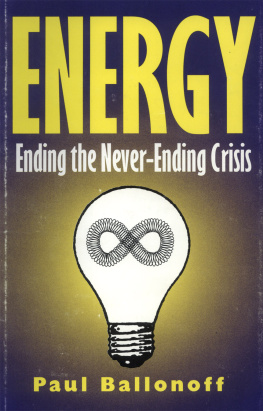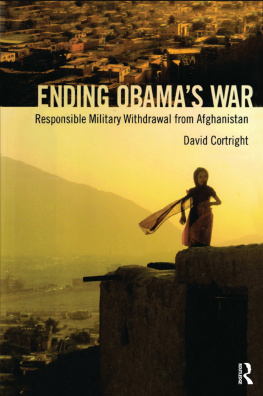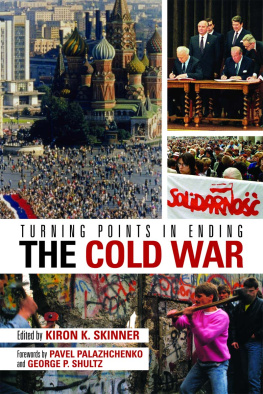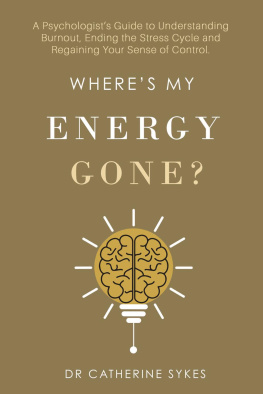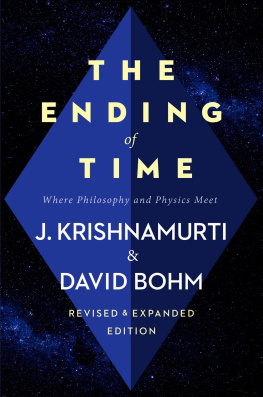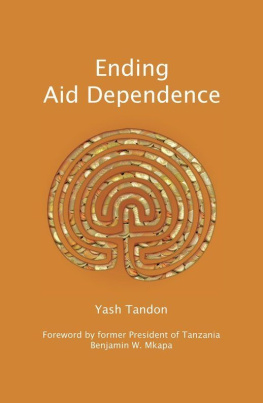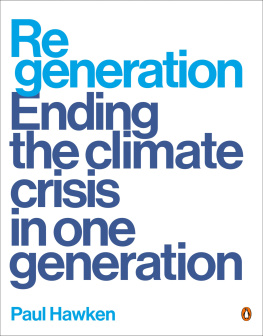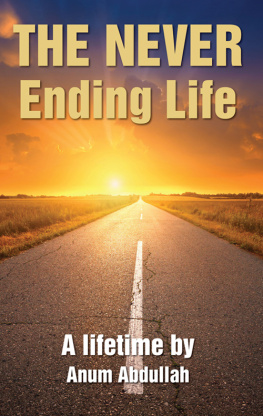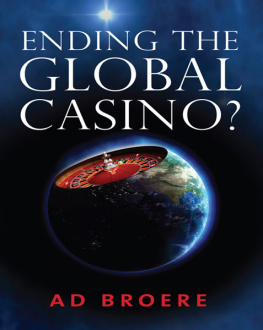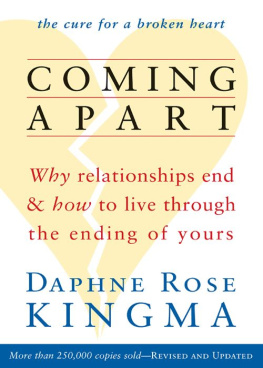
ENERGY
ENERGY
Ending the Never-Ending Crisis
Paul Ballonoff
INSTITUTE
Washington, D.C.
Copyright 1997 by the Cato Institute.
All rights reserved.
Library of Congress Cataloging-in-Publication Data
Ballonoff, Paul A.
Energy: ending the never-ending crisis / Paul Ballonoff.
p. cm.
Includes bibliographical references and index.
ISBN 1-882577-45-0 (cloth). - ISBN 1-882577-46-9 (paper)
Energy policy-United States. 2. Public utilities-Law and legislation-United States. 3. Energy industries-Government policy-United States. 4. Energy industries-Deregulation-United States. 5. Trade regulation-United States. I. Title.
HD9502.U52835 1997
CIP
Printed in the United States of America.
C ATO I NSTITUTE
1000 Massachusetts Ave., N.W.
Washington, D.C. 20001
Preface
The Path of This Book
When I was young, my favorite poem was Robert Frost's "The Road Not Taken." Never afraid of being alone on the highway, I certainly followed several less traveled paths in the work that led to the text before you. The final destination, however, was unexpected. The book began as a study of the persistent failure of energy price forecasting and its attendant consequences. But it became difficult to understand a century of intellectual failure in an era when so much political, economic, and cultural analysis claims to have some "scientific" mooring.
Real science is tested by contrasting predictions with reality. When scientific predictions persistently fail to reflect what is known to be real, theory is reworked to reflect reality more accurately. That this has not occurred in the realm of energy policy and economics is astonishing. It requires explanation. It requires abandoning the well traveled roads, since they seemed to lead nowhere interesting.
Those relatively untraveled roads led me from energy forecasting to constitutional theory. First, it was necessary to understand the technical issues at hand. Having done so, it then became my duty to understand why and how an important area of public policy went so badly wrong. This led to an exploration of the political and legal context in which the policy arose.
To understand the traditional perspective, it was necessary to review the classic cases that laid the foundation for modern utility and energy law. My review led me to conclude that two constitutions exist: one written by the Founding Fathers and another arising from both historical accident and deliberate policy, not during the New Deal but a half century earlier, in the chaos that followed the Civil War and the subsequent rapid expansion westward.
What I discovered is that today's energy policy rests largely on a power that the federal government was never given; indeed, was intentionally not given. This book calls that power the "general patent power." The name is used to describe governmental allocation of special economic rights, a power that the federal government simply does not possess. The term distinguishes the general patent power from the more specific patent power-related to new inventions-which the federal government does indeed possess.
Acknowledgments
I want to acknowledge five individuals or institutions whose influence inspired me to write this book. First, as usual, but with more than the usual influence, must be my undergraduate instructors in microeconomics at the University of California at Los Angeles, principally Jack Hirshleifer and Harold Demsetz. Neither would have predicted my interest in the subject of this book. Even less in 1960 to 1964 could I have predicted the influence on me, in 1988, of Professor Demsetz's 1968 paper "Why Regulate Utilities?" (Journal of Law and Economics, vol. 11, Apri11968, pp. 55-65).
The problem posed by this book is the same one posed by Demsetz, though the solution offered here is different. In some ways, Demsetz's solution is more radical than mine: he would seek a market alternative to utility regulation by substituting periodic auction of local utility rights, whereas I propose a much more ordinary market with no more than the same antitrust regulation applied in the rest of the economy. Demsetz implicitly accepts the existence of "natural monopoly" scale economies in utility costs. I believe the relative scale economies are not very large and in particular believe they do not amount to natural monopoly and, hence, I recommend different solutions to the problem of inefficient regulation. But I would not have reached my solution at all without having studied, in the 1980s, Demsetz's earlier analysis. I did so at the suggestion of Professor Hirshleifer, who always has been forthcoming with intellectual support for a former student short of knowledge but long on problems.
Two further acknowledgments arise from my decade of employment in state regulation, divided equally between the Kansas State Corporation Commission and the Illinois Commerce Commission. The 1980s were an intellectually exciting period to be working in the regulated energy industry. Kansas provided the practical experience, and Illinois the intellectual stimulation, to explore the problems discussed in this book. In Kansas I had the opportunity to read the literature on the theory of utility regulation, and encountered the works of Richard Posner. In "Natural Monopoly and Its Regulation" (Stanford Law Review, February 1969, vol. 21, no. 3, pp. 548-643), Posner argues that utility regulation cannot improve on uncontrolled natural monopoly, assuming of course that such things even exist. Posner summarizes (page 549):
This study has convinced me that in fact public utility regulation is probably not a useful exertion of government powers; that its benefits cannot be shown to outweigh its costs; and that even in markets where efficiency dictates monopoly we might do better to allow natural economic forces to determine business conduct and performance subject only to the constraints of antitrust policy.
In many ways this conclusion also summarizes the substance of the present book, at least regarding claims about the existence of natural monopoly as a basis for utility regulation. Unlike Posner, however, I provide the reader with data about utility costs and the possibility of multiple distribution grids to demonstrate that utility competition is indeed possible. In addition, I believe in the viability of the II antitrust optionll for completely different reasons than those of Posner, who, though writing in a law journal, hardly discusses the legal foundations of regulation at all. Indeed, the analysis of the constitutional basis (or lack thereof) for regulation in this book is, so far as I can determine, an original contribution to the literature.
Another source of ideas in this book was the opportunity for development of concepts provided by the biennial European Meetings on Cybernetics and Systems Research at the University of Vienna, Austria. I first presented many of my ideas in papers prepared for the 1988 and 1990 sessions.
The last source was National Economic Research Associates, Inc., a firm for which I was a consultant. I first discussed several of the key ideas found here-especially those of Chapters and 2-in projects for the firm's clients. I especially thank Michael Rosenzweig, a vice president of the firm in their Washington, D.C., office, for encouraging my work on some of these ideas.
 ENERGY
ENERGY 

